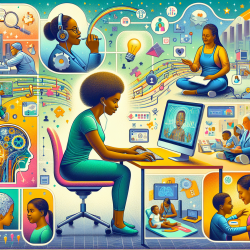Introduction
The rapid advancement of digital technology, telemedicine, and artificial intelligence (AI) has transformed various fields, including ophthalmology, as discussed in the research paper "Digital technology, tele-medicine and artificial intelligence in ophthalmology: A global perspective" by Li et al. (2020). These innovations have also shown significant potential in enhancing speech-language pathology, particularly in providing online therapy services to children. This blog explores how practitioners can leverage these technologies to improve their skills and outcomes in pediatric speech-language therapy.
Digital Technology and Teletherapy
Teletherapy, enabled by digital technology, offers a platform for speech-language pathologists to deliver services remotely, overcoming geographical barriers and increasing accessibility for children in underserved areas. The integration of teletherapy into clinical practice has been accelerated by the COVID-19 pandemic, necessitating the rapid adoption of digital solutions to maintain continuity of care.
Practitioners can improve their teletherapy services by utilizing high-quality video conferencing tools, digital assessment platforms, and interactive therapy applications. These tools facilitate real-time interaction, enabling therapists to conduct assessments, deliver interventions, and monitor progress effectively. Moreover, the use of secure platforms ensures compliance with privacy regulations, safeguarding patient data.
Artificial Intelligence in Speech-Language Pathology
AI has the potential to revolutionize speech-language pathology by providing data-driven insights and automating routine tasks. AI algorithms can analyze speech patterns, identify speech disorders, and suggest personalized intervention strategies. For instance, AI-powered applications can assist in diagnosing articulation disorders by analyzing phonetic errors and recommending targeted exercises.
Additionally, AI can enhance therapy outcomes by providing predictive analytics, helping practitioners identify at-risk children and tailor interventions accordingly. By integrating AI into teletherapy platforms, speech-language pathologists can offer more precise and effective treatments, ultimately improving children's communication skills.
Encouraging Further Research and Implementation
While the current research highlights the benefits of digital technology and AI in ophthalmology, similar advancements can be applied to speech-language pathology. Practitioners are encouraged to explore these technologies further and consider their implementation in clinical practice. Engaging in interdisciplinary research and collaboration with technology experts can lead to the development of innovative tools tailored to the needs of speech-language therapy.
Moreover, practitioners should advocate for the integration of digital innovations into educational curricula and professional development programs. By staying informed about emerging technologies and their applications, speech-language pathologists can enhance their skills and provide high-quality care to children.
Conclusion
The integration of digital technology, telemedicine, and AI into speech-language pathology holds great promise for improving therapy outcomes for children. By embracing these innovations, practitioners can overcome traditional barriers to care, offer personalized interventions, and achieve better communication outcomes. As the field continues to evolve, ongoing research and collaboration will be essential to harness the full potential of these technologies.
To read the original research paper, please follow this link: Digital technology, tele-medicine and artificial intelligence in ophthalmology: A global perspective.










